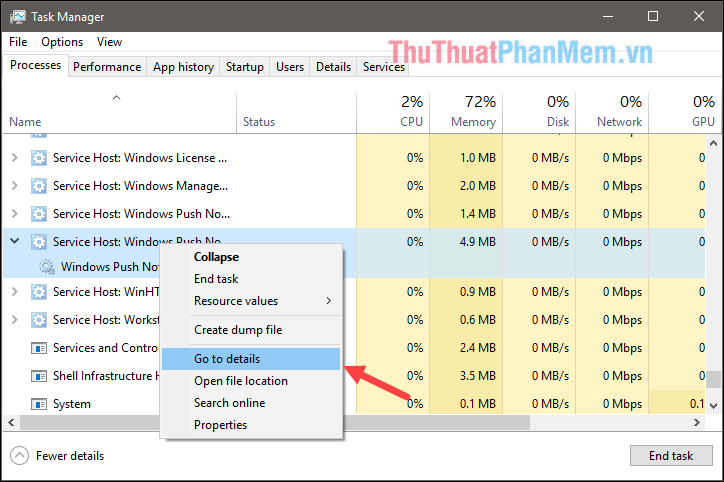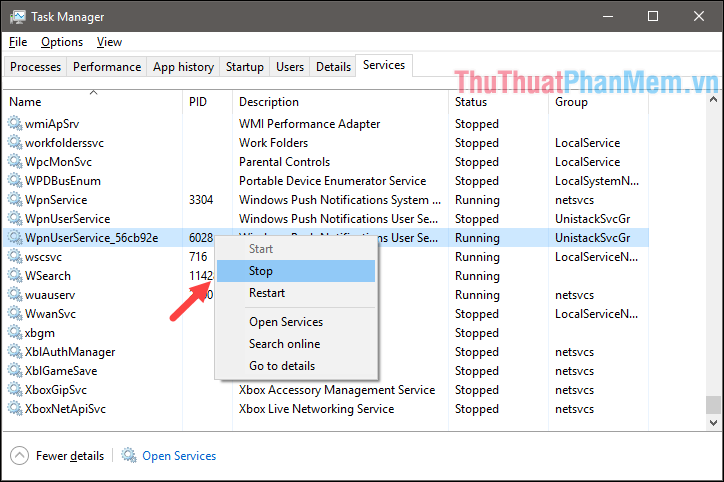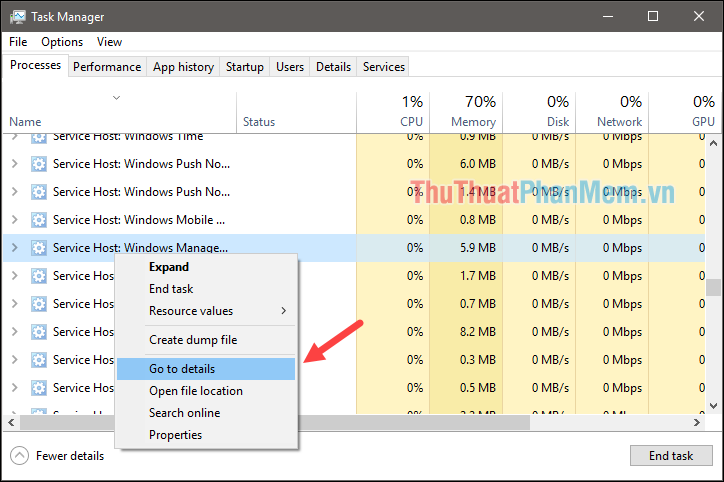How to handle svchost.exe taking up RAM and CPU
Svchost.exe is the name of a process (process) to help support some services running on windows. When we look at Task Manager, there are so many svchost.exe processes running, why are there so many processes coming? The answer is because they are divided into different jobs to help windows work better. For example, in one such process group, three processes are used for the firewall, the other one is for the user interface, etc. You can turn off unnecessary services by disabling or temporarily stop services that do not need to run. In addition, if you find that a svchost.exe is taking up a lot of CPU performance you can restart services running under that svchost.exe. The biggest problem is determining which services are being run in a particular svchost.exe, the following article is by TipsMake.com will guide you how to handle Svchost.exe causing a lot of RAM and CPU usage.
1. Check Svchost.exe processes with the command line
Open Command Prompt then type 'tasklist / SVC' and press Enter.
By doing this you will be able to see all the svchost processes running but we cannot understand what those processes are.

2. Check Svchost.exe processes with Task Manager
Open Task Manager by right-clicking on the Taskbar and then selecting Task Manager.
If you're using Windows 8 or Windows 10, the processes show up in the Processes tab on Task Manager. If a process takes on the role of Host with multiple services, you can view these services by expanding the process. This makes it easy to determine which service the program is running.

You can right-click on the service and select Go to details to see details of Processes

From the detailed display of processes, depending on the version of Windows, you can right-click on a specific svchost.exe, then select ' Go to Service (s) '.

This will take you to the Services tab, where services running under the svchost.exe process will be selected. Here you look in the Description column to know which service the application is and you will be able to stop the service of that application if you find it unnecessary.

To stop a service, just right-click on that service and choose Stop :

3. Check if the process is a virus
The process itself is an official part of Windows. Although the virus may have replaced the Service Host with an executable file of its own, this is very unlikely.
If you want to be sure, you can check the file location of the process. On Task Manager, right-click on any Service Host process, and select Option File Location .

If the file is stored in the WindowsSystem32 folder, you can rest assured it is not a virus.

To be sure, you should also use anti-virus software to scan for any processes that are viruses or not.
Above are some steps to check the svchost.exe taking up a lot of ram in windows and how to handle the svchost.exr. Thank you for following the article.
You should read it
- What is Svchost.exe? How to check if svchost.exe contains a virus?
- How to fix Svchost.exe error permanently using multiple CPUs
- About svchost.exe
- What is the ctfmon.exe, svchost.exe file?
- Fix SVCHOST.EXE application with error 0x745f2780
- How to set up the Xbox One gaming console on Windows 10
- Microsoft has allowed the use of the Xbox One handle on Windows
- How to Replace an RV Waste Valve Handle
May be interested
- 7 best distraction-free note-taking apps for Windows
 while many modern note-taking apps offer some benefits, they often include unnecessary features and can be a waste of your time.
while many modern note-taking apps offer some benefits, they often include unnecessary features and can be a waste of your time. - 5 most popular photography trends you need to know
 if you are a professional photographer, a creator who likes to learn about photography art or a designer who often uses copyrighted images in creative products, do not ignore this article.
if you are a professional photographer, a creator who likes to learn about photography art or a designer who often uses copyrighted images in creative products, do not ignore this article. - Photograph fireworks with smartphone camera
 most smartphone and tablet users want to show off their photography in the fireworks night. but with the camera quality on mobile devices, it is enough to bring you the best photos
most smartphone and tablet users want to show off their photography in the fireworks night. but with the camera quality on mobile devices, it is enough to bring you the best photos - What is Obsidian Note-Taking? Obsidian User Manual
 bored of traditional note-taking apps? so learn how to use the obsidian note-taking app to increase work efficiency!
bored of traditional note-taking apps? so learn how to use the obsidian note-taking app to increase work efficiency! - How to write notes online in Notepad
 notepad is an online note-taking service, completely free, can be managed anytime even offline.
notepad is an online note-taking service, completely free, can be managed anytime even offline. - A quick sense of Google Stadia game handle: Amazingly handy, amazing
 first
first - Take vitamin C properly don't forget these notes
 these are important notes you need to know to make the most of the effect of taking vitamin c.
these are important notes you need to know to make the most of the effect of taking vitamin c. - Top 10 note-taking apps for Linux
 in the digital age where ideas flow like a river, note taking has evolved from scribbled pieces of paper to amazing apps that help you add and organize notes with ease.
in the digital age where ideas flow like a river, note taking has evolved from scribbled pieces of paper to amazing apps that help you add and organize notes with ease. - How to see what is taking up a lot of storage space on Windows 10
 in this article tipsmake will guide you how to see what types of files are taking up a lot of storage space on your windows 10 computer.
in this article tipsmake will guide you how to see what types of files are taking up a lot of storage space on your windows 10 computer. - How to handle when the computer is infected with the Advertising Virus
 how to handle when the computer is infected with the advertising virus. when we use the internet, a lot of bad people want to access your device to install malware on your computer to advertise many things they want. if you are not awake, just press the wrong button, your computer will continuously show different ads.
how to handle when the computer is infected with the advertising virus. when we use the internet, a lot of bad people want to access your device to install malware on your computer to advertise many things they want. if you are not awake, just press the wrong button, your computer will continuously show different ads.










 How to fix exclamated network errors
How to fix exclamated network errors What software to install after reinstalling Windows
What software to install after reinstalling Windows Bring the Start Menu from Windows 7 to Windows 10
Bring the Start Menu from Windows 7 to Windows 10 Commands in CMD are common and useful in Windows 10
Commands in CMD are common and useful in Windows 10 How to schedule a computer to shutdown by Internet Download Manager
How to schedule a computer to shutdown by Internet Download Manager